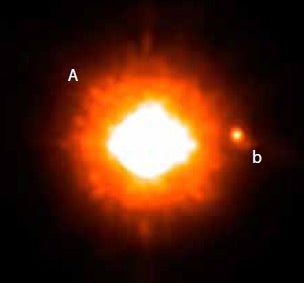For astronomical imaging purposes, “contrast” can be defined as the ratio of a planet’s flux to its star’s flux, where flux is essentially an object’s apparent brightness as we see it from Earth. To image an Earth-like planet at Earth’s distance from a nearby star, astronomers need an instrument capable of seeing contrasts of 10-10 (the contrast of the Earth-Sun system, a difference of 25 magnitudes) at a separation of 0.1″. A white dwarf in a binary system is likely not only brighter, but also farther from its companion star. For example, the nearest, brightest white dwarf, Sirius B (magnitude 8.5), is a mere 10,000 times fainter than its companion Sirius A (magnitude –1.4), and currently about 10″ away from it on the sky. It never gets closer to Sirius A than about eight times the Earth-Sun distance. For an exoplanet in Earth’s orbit around its star at the same distance as the Sirius system — 8.6 light-years away — an astronomer’s instrument would need to reach contrasts of 10-10 for objects separated by 0.4″. (The angular separation between a star and planet is based on the planet’s distance from the star, its eccentricity, and the system’s distance from Earth.)
The current list of directly imaged exoplanets contains objects several times Jupiter’s mass and about 10 to 100 times farther from their stars than Earth is from the Sun. Many of these planets are extremely young and still generating some heat — and thus, light — of their own as they form and contract. Some may even be brown dwarfs. None of these approaches Earth-sized planets. They were imaged by blotting out the parent star’s light; this technique still has significant limitations, but astronomers are working hard to push it to spot fainter, smaller, and closer-in planets.
Alison Klesman
Associate Editor










